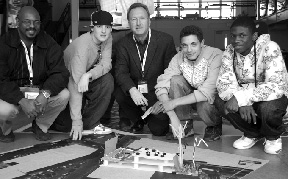Last month the American Institute of Architects (AIA) National Convention landed in Boston for the first time since 1992, bringing an estimated 25,000 industry professionals and $30 million in economic impact to the region, according to statistics released by the AIA. The largest gathering of architects in the United States, the AIA's annual convention brings trade and industry professionals together from around the globe.
This year's theme, "We the People," highlighted the role architects play in society. Selected by AIA president, Marshall Purnell FAIA, the theme set the stage for an exploration of how architects and architecture shape communities. "We are the people we serve and we live in the communities we have designed. We are the stewards of the safety and health of our children and our elderly in their places of care," said Purnell.
Within New England, as with the rest of the nation, architecture and engineering contribute significantly to the health of the economy. As the third-largest sub-sector of employees within the region's creative economy, according to a 2007 study by the New England Foundation for the Arts, the architecture and engineering professions are drivers for New England's other vital industries. Documentary evidence has shown the role design plays in creativity, healing and learning. Moreover, 2002 United States Census data showed Mass. has the highest percentage of architects in its labor force compared to all other U.S. states, reinforcing the large role architects play in New England Business.
In addition to the profession's financial impact, architecture and the related design professions underpin the way societies live, work, learn and play. New approaches to design are creating opportunities for collaboration and communication within the public and private realm.
One such example of architecture's impact on community is the advent of cohousing, brought to the United States from Denmark in the early 1980s. Still relatively unknown but gaining momentum, cohousing developments are "mini-neighborhoods" designed so that inhabitants may enjoy both a private home as well as easy access to a "common house" where neighbors may gather for meals and events.
A relatively recent addition to the Jamaica Plain neighborhood of Boston, the Jamaica Plain cohousing development website says of itself, "Some people call it a return to the best of small-town America. Others say it's like a traditional village or the close-knit neighborhood where they grew up, while futurists call it an altogether new response to the social, economic and environmental realities of the '90s. They're all right." The National Cohousing conference will be seen in Waltham, on June 12-15.
Overall, the 2008 AIA convention set the stage for New England and Boston to continue discussions about how architecture focuses and reinforces society throughout the next year. Along with the aforementioned National Cohousing Conference, Mass. will host Build Boston the Boston Society of Architect's annual convention and expo, as well as the U.S. Green Building Council's Greenbuild International Conference and Expo in November of this year.









